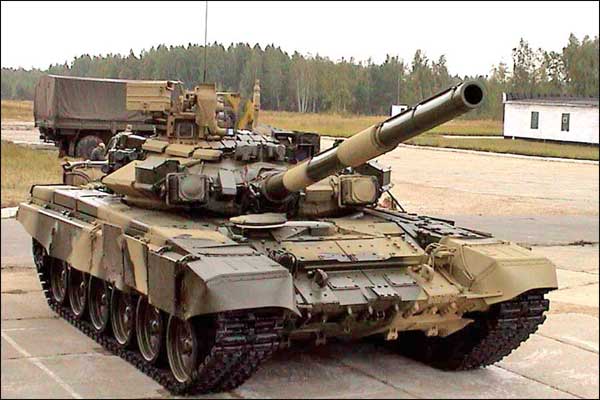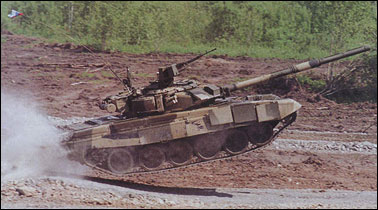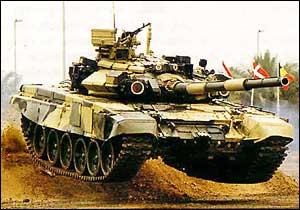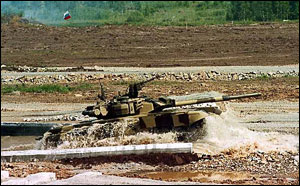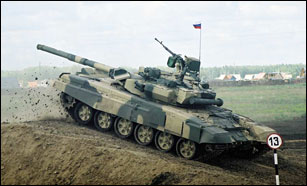|
Main | Wargames Section: |
Tiger Tanks Section:
|
Main Battle Tanks Section:
|
Main Battle Tank Prototypes: | Links
Russian T-90/T90S Main Battle Tank. Introduction: The T-90S is the latest development in the T-series of Russian tanks and represents an increase in firepower, mobility and protection. It is manufactured by the Uralvagonzavod Plant in Nizhniy Tagil (Potkin's bureau) of the Russian Federation. The T-90S is in service with the Russian Army and the Indian Army. In February 2001, the Indian Army signed a contract for 310 T-90S tanks. 124 were completed in Russia and the rest are being delivered in "knocked down/semi-knocked down" form for final assembly in India. The first of these was delivered in January 2004. The locally-assembled tanks are christened "Bhishma". The tanks are fitted with the Shtora self-protection system and thermal imagers from Thales of France and Peleng of Belarus. In January 2005, it was announced that a further 91 T-90S tanks would be procured for the Russian Army. 31 are due to be delivered in 2006. In March 2006, Algeria signed a contract for the supply of 180 T-90S tanks from Uralvagonzavod, to be delivered by 2011. In November 2006, India ordered a further 300 T-90 tanks, to be licence-built by Heavy Vehicle Factory (HVF), Avadi. Deliveries are to begin in 2008. History: Derived from the T-72, the GPO Uralvagonzavod T-90 main battle tank is the most modern tank in the Russian Army's arsenal. The successor to T-72BM, the T-90 uses the gun and 1G46 gunner sights from T-80U, a new engine, and thermal sights. Protective measures include Kontakt-5 ERA, laser warning receivers, and the SHTORA infrared ATGM jamming system. Kontakt-5 is a Russian type of third-generation explosive reactive armour. It is the first type of ERA which is effectively able to defeat modern APFSDS rounds. Introduced on the T-80U tank in 1985, Kontakt-5 is made up of "bricks" of explosive sandwiched between two metal plates. The plates are arranged in such a way as to move sideways rapidly when the explosive detonates. This will force an incoming KE-penetrator or shaped charge jet to cut through more armour than the thickness of the plating itself, since "new" plating is constantly fed into the penetrating body. A KE-penetrator will also be subjected to powerful sideways forces, which might be large enough to cut the rod into two or more pieces. This will significantly reduce the penetrating capabilities of the penetrator, since the penetrating force will be dissipated over a larger volume of armour. By 1992 the Russian Defense Ministry announced that it could no longer afford to manufacture two MBTs in parallel. Since both the "quality" T-80U and the cheaper "quantity" T-72B were each being built at one plant, and each plant was critical to the economy of the city it was in, the Government gave small orders to both. Omsk built five T-80Us and Nizhni Tagil 15 T-72s, and both built more against the hope of winning large export orders. Nizhni Tagil had built a few T-72BMs, T-72Bs upgraded with a third generation add-on Explosive Reactive Armor (ERA) called Kontakt-5, which was already in service on the T-80U MBT. Kontakt-5 has been succeeded by the newer Kaktus type, which is currently only seen on prototype tanks such as the T-80UM2 "Chiorny Oriol" (Black Eagle) tank. To further improve the T-72's export prospects and its chances of being selected as Russia's sole production MBT, the T-80U's more sophisticated fire control system was also added to produce a vehicle designated T-72BU. Finally, since worldwide news coverage during Desert Storm had firmly established the image of the T-72 as a burning Iraqi tank, the new model was renamed T-90. The Russian Defense Ministry made a selection of a single MBT in 1995. The fighting in Grozny had been shown around the world and the reputation of Russian tanks suffered. Although many casualties were due to bad tactics and many T-72s were also lost, it was the knocked-out T-80s which made an impression. More had been expected of the "quality" T-80 MBT. This is alleged to have tipped the balance against the T-80 in the selection. The T-80 was already more expensive and its delicate, fuel-hungry turbine engine was still giving problems. In January 1996, Col.-Gen. Aleksandr Galkin, Chief of the Main Armor Directorate of the Ministry of Defense, announced that the T-90 had been selected as the sole Russian MBT. The T-90 went into low-level production in 1993, based on a prototype designated as the T-88. The T-90 was developed by the Kartsev-Venediktov Design Bureau at the Vagonka Works in Nizhniy Tagil. Initially thought by Western observers to be an entirely new design, the production model is in fact based on the T-72BM, with some added features from the T-80 series. The T-90 features a new generation of armor on its hull and turret. Two variants, the T-90S and T-90E, have been identified as possible export models. Plans called for all earlier models to be replaced with T-90s by the end of 1997, subject to funding availability. By mid-1996 some 107 T-90s had gone into service in the Far Eastern Military District. Of conventional layout, the T-90 represents a major upgrade to every system in the T-72, including the main gun. The T-90 is an interim solution, pending the introduction of the new Nizhny Tagil MBT which has been delayed due to lack of funding. Produced primarily mainly due to its lower cost, the T-90 will probably remain in low-rate production to keep production lines open until newer designs become available. Several hundred of these tanks have been produced, with various estimates suggesting that between 100 and 300 are in service, primarily in the Far East.  T-90S, speeding out. The T-90 retains the low silhouette of the earlier Soviet tanks. The glacis is well sloped, and is covered by second generation ERA bricks and a large transverse rib that extends horizontally across the glacis. The driver sits at the front of the hull and has a single piece hatch cover that opens to the right, in front of which is a single wide-angle observation periscope. Integrated fuel cells and stowage containers give a streamlined appearance to the fenders. The tank has a toothed shovel/dozer blade on the front of the hull beneath the glacis. There are attachment points beneath the blade for the KMT-6 mine-clearing plow. The low, rounded turret is centered on the hull. The commander's cupola is on the right side of the turret; the gunner's hatch is on the left side. The 125-mm main gun has a four section removable thermal shield. It has two sections in front of, and two sections to the rear of the mid-tube bore evacuator. A 7.62-mm coaxial machine-gun is mounted to the right of the mantlet. The T-90 mounts two infra-red searchlights on either side of the main armament; these are part of the Shtora ATGM defense system. The turret is covered with second generation reactive armor on the frontal arc. This ERA gives the turret an angled appearance, with the ERA bricks forming a "clam shell" appearance. There are ERA bricks on the turret roof to provide protection from top-attack weapons. There are banks of smoke mortars on either side of the turret. The second generation ERA package, combined with the advanced armor technology, makes the T-90 one of the best protected main battle tanks in the world. Variants: The year 1999 saw the appearance of a new model of T-90, featuring the fully welded turret of the Obiekt 187 experimental MBT instead of the cast design of the original T-90. This new model is called "Vladimir" in honor of T-90 Chief Designer Vladimir Potkin, who died in 1999. It is unknown how this design affects the protection and layout of the turret, and whether the frontal armor package was also extensively redesigned (Source: Vasily Fofanov's Modern Russian Armor Page). There are at least three different variants of the T-90. The Russians confirmed the existence of an export variant in June 1996 with varying equipment and engine fits, and Russian promotional materials have discussed both the T-90S (or "C" in the sometimes-used Cyrillic non-translation) and the T-90SK command variant. The T-90SK command variant differs in radio and navigation equipment and Ainet remote-detonation system for HEF rounds. The T-90 "Vladimir", with a welded turret, is also referred to as T-90M, but it is not an official designation. The official designation for those tanks were T-90A, or T-90SM. Actually, all production T-90s from 2001 onwards have welded turrets, so it only seems logical to assume that the official designation now is T-90S (or "C") - what is confirmed by the fact that all T-90S MBTs sold to India have welded turrets. There are also occasional references to a T-90E, but these appear to be unsubstantiated. T-90S MBT Characteristics 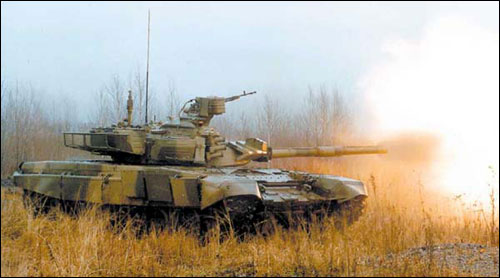 T-90S Main Battle Tank, firing the 125mm 2A46M smoothbore gun. Firepower: The T-90S armament includes one 125mm 2A46M smoothbore gun, stabilized in two axes and fitted with a thermal sleeve. The gun tube can be replaced without dismantling inside the turret. The gun can fire a variety of ammunition including APDS (Armour Piercing Discarding Sabot), HEAT (High Explosive Anti-Tank), HE-FRAG (High Explosive Fragmentation) as well as, the APERS (anti-personnel) ammunition, consisting of shrapnel projectiles with time fuzes. By far the most widely used APERS round is a multi-purpose HE/HE-FRAG/FRAG fin-stabilized round. Its versatility has been lately further increased by introduction of a time-fusing system, Ainet. Other APERS rounds include shrapnel and incendiary, but these are a lot less common. The 2A46 and 2A46M lines of mainguns (internal designations D-81T, D-81TM) were developed by the Spetstekhnika design bureau in Ekaterinburg (former Sverdlovsk), and are manufactured at the Motovilikha artillery plant in Perm. The T-90S gun can also fire the 9M119Refleks (NATO designation AT-11 Sniper), or the 9M119M Refleks (NATO designation AT-11 Sniper-B) anti-tank guided missile system. The 9M119 missile comes in two variants: the 9K120 Svir, which is fired by the T-72B, T-72S, and 2A45M antitank gun; and the Refleks, which is fired by the T-80B, T-80U, and T-90 main battle tank. The Refleks round is 4 kg heavier and has a 5,000 meter maximum range, whereas the Svir has a 4,000 meter maximum range. The range of the missile is 100m to 4,000m and takes 11.7 sec to reach maximum range. The system is intended to engage tanks fitted with ERA (Explosive Reactive Armour) as well as low-flying air targets such as helicopters, at a range of up to 5km. The missile system fires either the 9M119 or 9M119M missiles which have semi-automatic laser beam riding guidance and a hollow charge warhead. Missile weight is 23.4kg. The gun's automatic loader will feed both ordnance and missiles. Due to high cost of the system, usually only elite regiments shall have those missiles in a loadout. The Refleks 9M119 AT-11 SNIPER laser-guided missile with a hollow-charge warhead is effective against both armored targets and low-flying helicopters. The missile, which can penetrate 700-mm of RHAe out to 5,000 meters, gives the T-90S the ability to engage other vehicles and helicopters before they can engage the T-90S. The computerized fire control system and laser range-finder, coupled with the new Agave gunner's thermal sight, permit the T-90S to engage targets while on the move and at night. However, this first generation system is probably not as capable as current Western counterpart systems. The tank is fitted with precision laying equipment and an automatic loader to guarantee a high rate of gun fire. Also fitted is a coaxial 7.62mm PKT machine gun and a 12.7mm air defense machine gun. A 5.45mm AKS-74 assault rifle is carried on a storage rack. Fire Control: The T-90S has the 1A4GT integrated fire control system (IFCS) which is automatic but with manual override for the commander. The IFCS contains the gunner's 1A43 day fire control system, gunner's TO1-KO1 thermal imaging sight which has a target identification range of 1.2km to 1.5km and commander's PNK-S sight. The gunner's 1A43 day FCS comprises: 1G46 day sight/rangefinder with missile guidance channel, 2E42-4 armament stabilizer, 1V528 ballistic computer and DVE-BS wind gauge. The commander's PNK-4S sight includes a TKN-4S (Agat-S) day/night sight which has identification ranges of 800m (day) and 700m (night). The driver is equipped with a TVN-5 infrared night viewer.  T-90S, of the indian Army. The T-90S is one of the best protected MBTs in the world. Protection: The T-90S features the low silhouette of the earlier Russian tanks, with a low rounded turret centered on the hull, and is fitted with combined passive and active defenses which make the T-90S one of the best protected main battle tanks in the world. The glacis is covered by second generation explosive reactive armor [ERA] bricks, as is the turret. This ERA gives the turret an angled appearance, with the ERA bricks forming a "clam shell" appearance. ERA bricks on the turret roof provide protection from top-attack weapons. The T-90S is equipped with the TShU-1-7 Shtora-1 optronic counter measures system, produced by Electronintorg of Russia, which is designed to disrupt the laser target designation and rangefinders of incoming ATGM. The T-90S is also equipped with a laser warning package that warns the tank crew when it is being lased. Shtora-1 is an electro-optical jammer that jams the enemy's semiautomatic command to line of sight (SACLOS) antitank guided missiles, laser rangefinders and target designators. Shtora-1 is actually a soft kill, or countermeasures system, which is most effective when used in tandem with a hard kill system such as the Arena.
The complete system includes infrared jammer, laser warning system with four laser warning receivers, grenade discharging system which produces an aerosol screen and a computerized control system. It is also fitted with NBC (nuclear, biological and chemical) protection equipment. Mobility:
The T-90S has a liquid-cooled V-84MS 618kW (840 hp) four-stroke V-12 piston engine. This engine can be fueled by T-2 or TS-1 kerosene and A-72 benzine, in addition to diesel. The tank can carry up to 1,600 liters of fuel in the main fuel tanks and fuel drums. The fuel tanks are reinforced with armour plating. This engine results in a power to weight ratio of only 18.06 hp/ton, considerably less than that of the T-80U. The tank is provided with a snorkel for deep fording and can ford 5m of water with equipment which can be deployed in 20 minutes, to negotiate 5 meter deep water obstacles.
The mechanical transmission includes primary reduction gear, two planetary final gearboxes and two planetary final drives. The running gear features torsion bar suspension with hydraulic shock absorbers at one, two and six road wheel stations and tracks with rubber-metallic pin hinges. The tank is also fitted with the NBC protection system and mounted mineclearing equipment. Specifications: 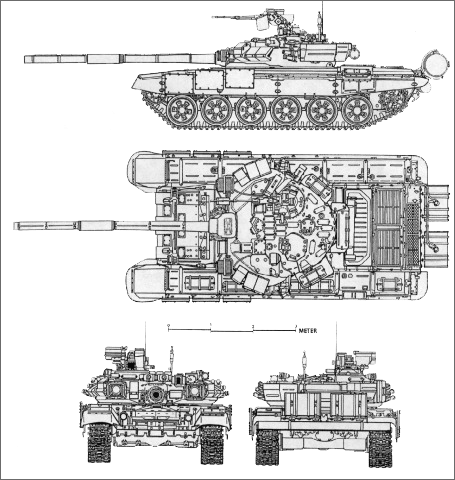
Sources: Vasily Fofanov's Modern Russian Armour Page Kharkiv Morozov Machine Building Design Bureau - KMBD Uralvagonzavod (Dzierzhinsky Ural Railroad Car Works) - UVZ The ARMOR Site! is © Copyright 1997-2007 Fabio Prado . All Rights Reserved. |
||||||||||||||||||||||||||||||||||||||||||||||||||||||

